Once again, the strong influence of Bengali community is visible in the cuisine of Tripura, as Rice and Fish make the essential ingredients. People prefer eating non-vegetarian delicacies on top of vegetarian food. In most of the families, one can see preparation of authentic Bengali food. Pork, chicken, mutton, beef, turtle, fish, prawns, crabs, and frogs are consumed profusely by the non-vegetarians. Some of the traditional Tripuri delicacies are Chakhwi, Mwkhwi, and Muitru.
. 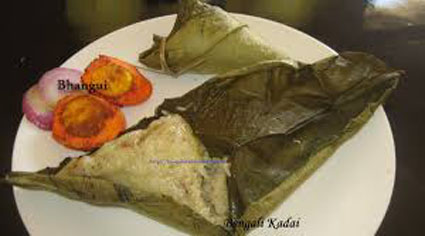
|
|
The traditional costume of a male in Tripura is 'rituku' for the loin and 'kamchwlwi borok' for the upper part of the body. Sometime these are topped off by a self-woven shirt, called Kubai. But however now in urban areas with modernization there are lot of western influence in the costumes. Rinai is a piece of long cloth which is used by the women of Tripura to drape it around their waist and it goes up to their knee. Risa is considerably a small piece of cloth to that of the Rinai and is used to cover the entire chest area of the body. . The women of Tripura adorn themselves with plethora of beads and coin strands in their necks. During dance performances the female performers wear a head gear which is made of coronal, made of brass and colored cane, further embellished with porcupine quills. Green feathers of the parrot`s wings, decorated at their tips, with tussocks of contrasting red wool decorate the upper edge of the quill. They generally prefer silver ornaments like chains made of coins, bangles, ear and nose rings.
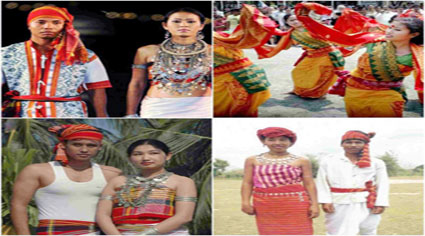
|
|
Music Music is integral to the tribal lifestyle. Some of the aboriginal instruments, developed in Tripura, are Sarinda, Khamb (Drum), Lebang, Do- Tara, Chongpreng, Khengrong, and Sumui (a kind of flute). Be it the occasion of marriage, religious ceremony or other festival, songs are sung to commemorate each event in the state. The renowned musicians, Sachin Dev Burman and Rahul Dev Burman, belonged to Tripura.
Dance Dance is a vital constituent of the tribal way of life. Where some dance forms are exclusive to some occasions, there are many others to mark celebration of different events. For example, Garia dance symbolizes the prosperity of the people, Hai Hak and Cheraw dances depict the confinement of Lusai woman. In Tripura, Basanta Raas is a delightful dance form of the Hindu Manipuris. Apart from the above-mentioned, there are many other dance forms, like Hojagiri, Bihu, Wangala, Sangraiaka, Chimithang, Padisha, Abhangma, Gajan, Dhamail, Sari and Rabindra, which belong to and are performed by different communities.
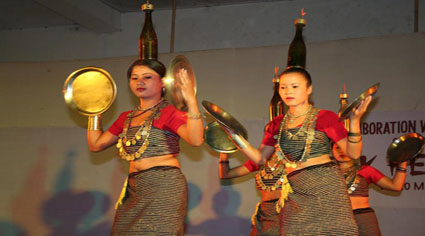
|
|
Since Tripura is mainly subjugated by the Hindus, the festivals common in rest of the country are mostly celebrated here. For example, festivals like Durga Puja, Navaratri, Vijayadashami, Dol Jatra (Holi), Pous Sankranti, Ashokashtmi, and Diwali are the most celebrated festivals. Besides, there are many other festivals that are unique to Tripura. Some of the important tribal festivals are Garia, Ker Ganga and Gajan. Other state festivals are Rabindra/Nazrul Festival (May), Boat Festival (August), and the Orange and Tourism festival (November).
The main festivals ofTripura are the Durga Puja (at the time of Dussehra), Karchi Puja,Diwali, Dol Jatra(Holi), Pous Sankranti, Ashokashtmi and Buddha Jayanti, Id, Christmas and New Year. The Garia, Ker Ganga and Gajan festivals are important tribal festivials
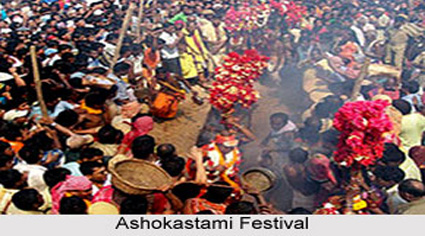
|
|
Since the people of Tripura belong to a blend of various tribal communities, they follow different customs and traditions. According to the Reang community the marriages are fixed by a matchmaker who is widely known as Andra where he does the initial negotiations between the boy's and the girl's family. When the marriage is finalized the guests are served with pork, rice and rice beer. The wedding is performed by the Ochai. Child marriage is not encouraged in this community and also widow marriage can take place only after one year of the death of the husband. The widow and widower are not allowed to participate in any social or religious gathering one year after the death of their spouses. A widow is not allowed to wear any ornaments after the death of her husband. They do not have any dowry system but however the groom has to spend for two years to the father- in -laws' house before the wedding.
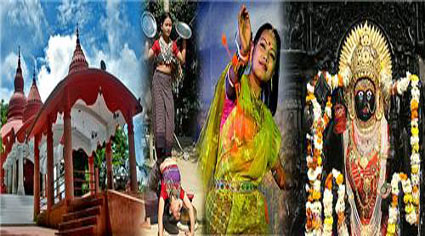
|
|
The novelty of the state's art & craft comes alive in its handicrafts and handlooms. Handloom products make the vital part of the economy of Tripura. Silk, cane and bamboo works are some of the main industries. Here skilled artisans craft a fascinating variety of handiwork using simple materials, such as, bamboo, cane, palm leaves and ordinary yarn. Some of the popular handicraft items are bamboo screens, lamp stands, baskets, ivory work, tablemats, sitalpati, woodcarving, silver ornaments and other crafts.

|
|







